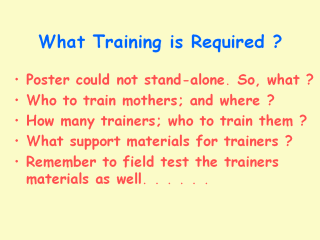| front |1 |2 |3 |4 |5 |6 |7 |8 |9 |10 |11 |12 |13 |14 |15 |16 |17 |18 |19 |review |
 |
The poster could
not stand-alone because the comprehension rate for adding the salt was too
low, and could not be raised further. Thus young mothers needed to be told
about the salt so that the 65% who didnít recognise it without prompting,
would remember it every time they saw the poster. For Baluchestan, it was
felt that Family Health Workers (FHWs) working out of clinics were ideal for
the job. They handled both ante-natal care and well baby clinics for
vaccinations and Vitamin A supplementation. Virtually every mother in
Baluchestan passed through the hands of an FHW during pregnancy and in the
well baby clinics. Ideally, every young mother could be provided her own
poster which would have been explained to a group of young mothers by the
FHW. The training would be done in the clinics. While there were adequate numbers of FHWs to contact all mothers, because Baluchestan covers 43% of the land area of Pakistan, travelling to train all of them with a mobile team was impractical. Thus it was accepted that a small group of trainers would be trained and they would in turn train the FHWs. We proposed to train the trainers ourselves; and for the trainersto undertake the training of the FHWs Ė who in turn would train mothers in the clinics. An analysis of the needs for the trainers and FHWs showed that all they required was a flipchart with the 11 individual pictures on 11 sheets (of stiff card so it could stand by itself). On the reverse of the flipchart was a short bullet list of points needing to be made about each picture. The next slide shows how the flipchart works. The field test which was applied to the FHWs and trainers focussed on their ability to understand the pictures and to be able to read the text on the back of the flipchart. |